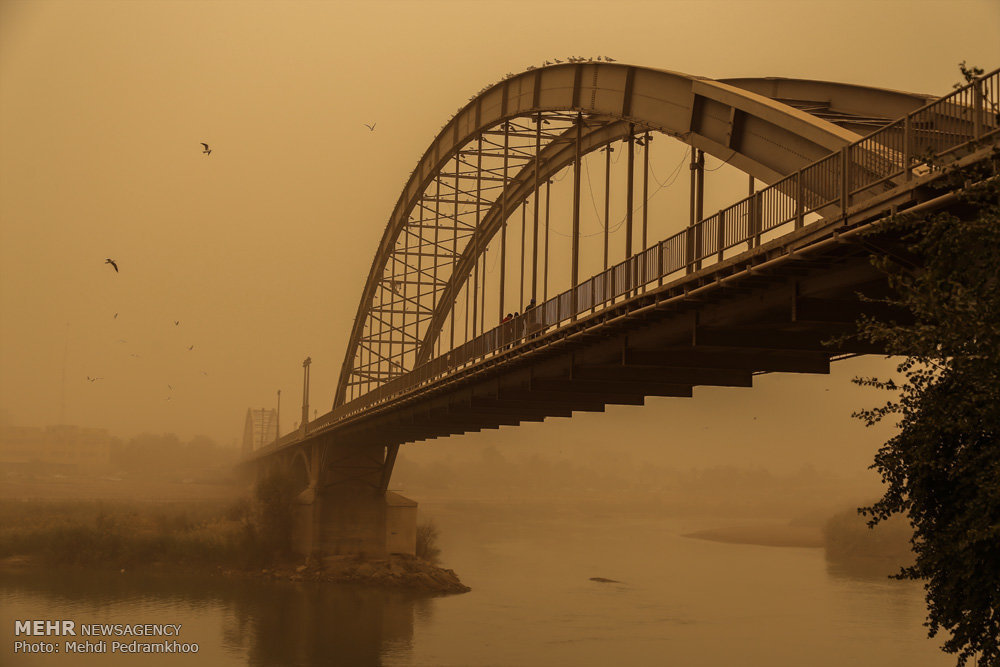SDS hotspots in Ahwaz 5 times larger than Tehran

Geological researches demonstrate that the hotspots for sand and dust storms (SDS) developed around the city of Ahwaz, in the southwestern Khuzestan Province, cover more than 350,000 hectares of land, 5 times bigger than Tehran urban area.
There are seven different SDS hotspots near Ahwaz, each having special land use and specific reason behind their development as the source of this environmental predicament.
A brief history of the challenge
It was around the year 2005 that the first signs of sporadic SDS appeared in southwestern Iran. Just seven years later, sand and dust storms became so persisting and terrible that turned into environmental circles’ hot topic.
Now after 14 years, unfortunately, the issue still remains and even aggravates year on year, depriving the people of those areas from the right of breathing clean air.
To have a tangible sense of the situation, here are the concentration of fine dust in some cities of Khuzestan Province published on January 20.
According to Khuzestan provincial department of environment, the concentration of fine dust in Ahwaz, Behbahan and Masjed Soleyman stood at 627, 2926 and 2056 micrograms per cubic meter. This is while the normal level of fine dust concentration is 150 micrograms per cubic meter.
Internal SDS hotspots vs. external ones
Although experts still wrangle over the extent of the impacts of external and internal SDS hotspots, almost all of them agree that the former has a bigger share in this regard.
Estimations show that around 70 percent of SDSs are originated from outside Iran, the director of Khuzestan Province meteorological organization Kourosh Bahadori told Khabaronline on Wednesday.
Although water scarcity is the main reason behind SDSs, there are some other factors which have deteriorated the situation.
Having a rather small 30-percent share is surely not a valid excuse to neglect internal hotspots, said Bahadori, adding, SDSs fed by these sources reach southwestern cities more quickly and have higher concentration. However, due to having larger dust particles, these storms have a shorter stay, he concluded.
What are the causes behind SDSs?
Certainly, long-lasting drought in the region is the number one culprit.
The report by meteorological organization which considers Standardized Precipitation Evapotranspiration Index (SPEI) over the past 84 months, shows that 27 percent of Khuzestan Province area is facing extreme drought. The report also indicates that 65.9 and 6.4 percent of the province is suffering from severe and moderate drought respectively.
Although water scarcity is the main reason behind SDSs, there are some other factors which have deteriorated the situation.
Civil projects impacting grasslands
The area of Khuzestan’s grasslands and pastures which have turned to deserts in recent years account to more than 200,000 hectares, making it the widest area of land responsible for SDSs.
No one can deny the negative effects of drought here but it seems that some civil projects like building roads and railroads have accelerated the transition.
Dams and excessive water withdrawal
Not very long ago, there were some lands in the region that didn’t have any vegetation but were made wet by seasonal floods. Lack of precipitation, inordinate dam building projects and excessive withdrawal from both surface and underground water resources took the moisture form these lands and unlocked their great potential to turn to the source of a disaster.
The same scenario goes with wetlands as well. For instance, considerable part of Hour-al-Azim lagoon has turned into desert, although during recent years its situation has a bit improved with receiving more water from dams.
“We have no right to adopt measures based on researches that have been conducted in 1360s [1980s] … the water that existed 30 years ago hasn’t remained now,” said the chief of the Department of Environment Isa Kalantari in a live TV interview last week, criticizing the policies of the Ministry of Energy in the region.

Planting trees; one of the solutions
The administration has started planting trees in the region to stabilize the soil and prevent further SDSs in a long run. The officials claim that some 30,000 hectares of SDS hotspots will be covered by tree planting programs till the end of the current [Iranian calendar] year (March 20). The required water for this project will be provided by Karun River through a pipeline.
What is the stand of ‘clean air law’ on SDS?
Clean air law was adopted by Majlis (the Iranian parliament) in July 2017. Comprising 34 articles, the law takes unprecedented steps to provide the right of clean air for Iranians.
The new law and its guidelines (still under development) clearly define the responsibilities of different organizations on the battle against air pollution and sand and dust storms.
As per an article of the law, the Ministry of Agriculture is tasked to conduct at least 300,000 hectares reforestation per annum, with the priority of areas facing with crisis, SDS hotspots and sensitive ecologies. And the administration should allocate the required budget in its budget bill.
According to another article, the Ministry of Energy should provide the water right of wetlands based on precipitation status, with the Department of Environment monitoring the process.
As far as external SDS sources are concerned, surely Iran cannot tackle the issue alone and deeply needs the help of international environmental bodies.
However, for the internal hotspots we have no excuse for further procrastination. We have to modify our water withdrawal and water transfer policies along with our irrigation systems in the agriculture sector as soon as possible.
MAH/MQ/MG
Leave a Comment